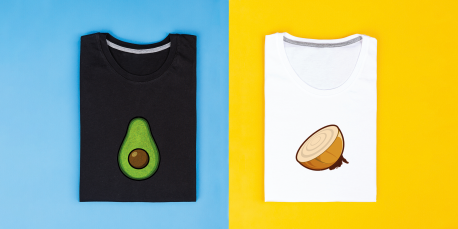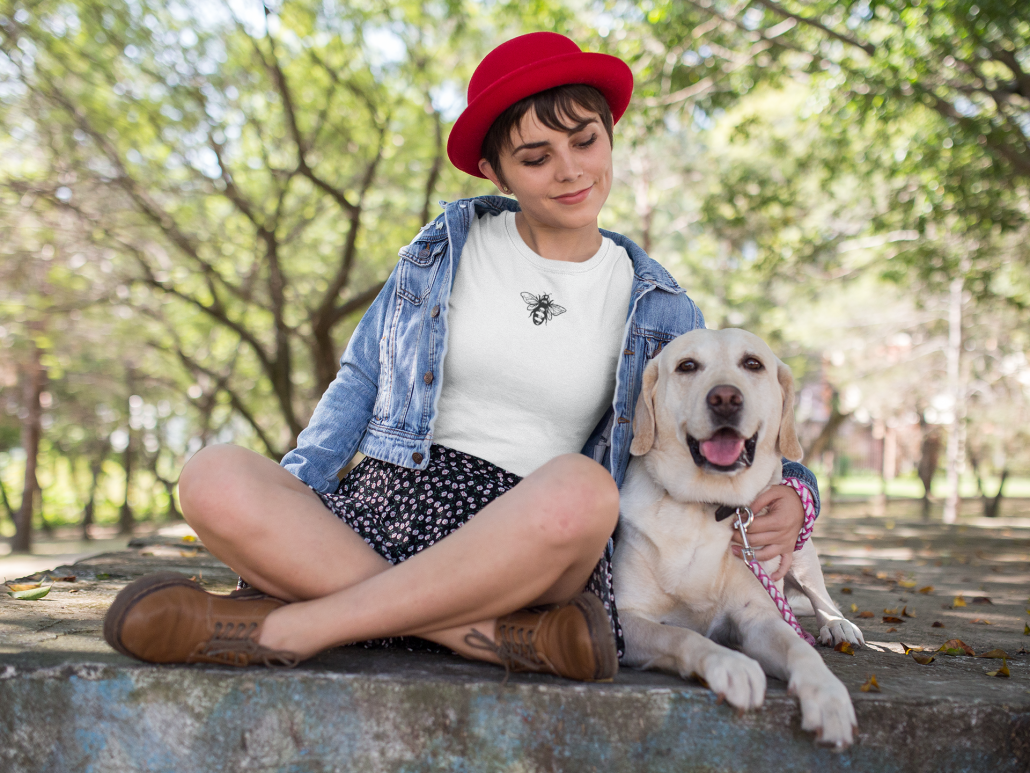How to: Customize a T-Shirt with Natural Dye

What do avocado pits, onion peels, and chamomile have in common? They can be found in your kitchen cupboards and make excellent natural fabric dyes. If you want to go –au naturel— with your next dye project, read on!
Phase 1: Find inspiration
More sophisticated than tie-dye at summer camp, but just as fun. When working with natural plant dyes, it’s good to have a little bit of vision for your project. Start by brainstorming a color palette. Consider if you want your T-shirt to be one solid color or if you prefer a unique pattern. Spend some time with your plant friends and doodle your botanical-loving heart out! Using the customize tool on our website, you can add super sweet designs or text—and then you can really make it yours with some DIY plant dye at home.
Phase 2: Choosing your dye plants
Dye plants come in a variety of shades. For example, there is madder root which create a vibrant red. Or avocado pits which dye fabrics a light pink. If you’ve decided you love the color pink and that is the only dye you want to use—great! Then avocado pits it is. If you prefer a wide variety of colors, consider choosing dye plants that are primary colors. With techniques like overdyeing or by allowing your T-shirt to sit in the dye bath overnight, you can create an entire array of colors. Choose one (or more) of the options below.
Red dye
- Madder root (a vibrant red)
- Avocado pits (pink)
Yellow dye
- Onion peels (a golden yellow)
- Chamomile (light yellow)
- Weld (light yellow)
Blue dye
- Indigo (dark blue)
- Woad (blue)
Phase 3: Gather your materials
Some dye materials you can collect or easily find in your kitchen. Others are not so easy to source. If you want to dye more frequently, check out natural dye kits online, such as the Kaliko Dye Garden Starter Kit.
Additionally, when sourcing your dye materials, you need to consider mordant. This is a substance you’ll add to the dye bath to ensure the color is able to properly bind with the fibers. The type of mordant you need depends on two things: what you are dyeing with and if the material is cellulose (linen, cotton, hemp, etc) or protein (silk, wool, etc). For the sake of simplicity, let’s focus on cotton materials. For this project and the most non-toxic solution, we recommend using salt as a mordant. Please note, a two-step mordant process is recommended and traditional for cellulose fibers. These often require more complicated procedures, lots of math, and using chemicals like alum as the mordant. For this project, we are more focused on experimentation and creating! For this reason, we will use salt as a mordant.
You’ll also need a wooden spoon, a large stainless-steel pot, and gloves.
Once you have your dye materials, it is time to find your canvas. For a totally unique project, we recommend dyeing a T-shirt, tank top, or bandana. Make your project even more personal with a flower motif or botanical design.
Phase 4: Let’s get this (dye) party started
Dyeing with plants can be fun solo or with a group. Plus, the final product makes for a really unique gift idea. Who wouldn’t love a custom bandana? So, turn on some music and let’s get dyeing!
- Soak your T-shirt in warm salt water overnight. Use ½ cup of salt per 6 cups of water. The following morning, you should rinse the T-shirt and wring out as much water as possible.
- Fill your pot with hot water, make sure that there is space for the fabric to rest comfortably in the pot without overflowing. Add your T-shirt.
- Add your chosen dye. We’ll use avocado pits as the example here. Make sure the pits are cleaned. The more pits you add to the pot of water—the more vibrant the color will be. This is a rule of thumb for most dye materials.
- Bring the water to a boil, let sit until you are content with the color. Then remove and let dry.
If you want to overdye and create more colors try this:
- Repeat the steps above with a second pot of hot water.
- Add lots of chamomile. You can add the chamomile to a loose-leaf tea bag or let it float freely in the pot. Let it boil for over an hour.
- Wring out the T-shirt from the avocado dye bath. Add the now pink T-shirt to the chamomile dye bath. The longer you leave the T-shirt in the chamomile dye bath, the more orange it will be. The shorter amount of time it’s left there, the lighter the color will be.
*The process of overdyeing can happen with pretty much any combination of colors. For example, if you dye a T-shirt with woad and then overdye it with onion skins for a short amount of time (15 minutes tops), you end up with a lovely olive-green color.
Once you have finished dyeing your T-shirts, rinse them in cold water. If you wash them, be sure to use gentle detergent, cold water, and wash separately.
The world of plant dyeing is enormous and wonderful. Enjoy your newly customized T-shirt featuring our gorgeous botanical designs.






